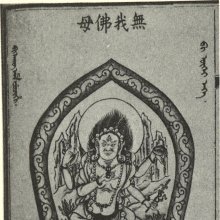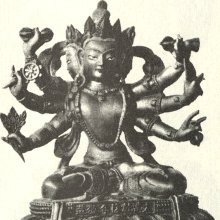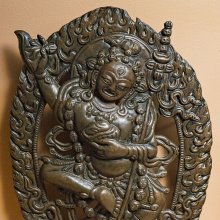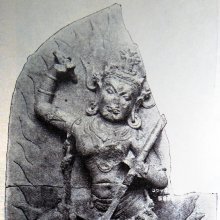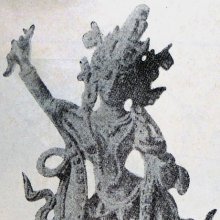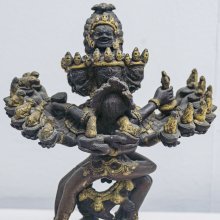Nairatma, Nairātma, Nairātmā: 4 definitions
Introduction:
Nairatma means something in Buddhism, Pali, Hinduism, Sanskrit. If you want to know the exact meaning, history, etymology or English translation of this term then check out the descriptions on this page. Add your comment or reference to a book if you want to contribute to this summary article.
Images (photo gallery)
(+8 more images available)
In Buddhism
Tibetan Buddhism (Vajrayana or tantric Buddhism)
Source: archive.org: The Indian Buddhist Iconography1) Nairātmā (नैरात्मा) refers to one of the female emanations of Akṣobhya, as mentioned in the 5th-century Sādhanamālā (a collection of sādhana texts that contain detailed instructions for rituals).—Her Colour is blue; her Āsana is dancing in ardhaparyaṅka; her Appearance is terrible; her Vāhana is a corpse lying on its back; her Symbols are the kartri and kapāla.—Two sādhanas in the Sādhanamālā describe her form, which is in many respects, similar to the form of Vajravārāhī with the kartri and the kapāla, the principal point of difference being the position of the corpse which forms their vāhana, When it lies on its chest it is Vajravārāhī, but if it lies on its back the goddess is Nairātmā.
The word ‘Nairātma’ means ‘no-soul’ and is another name for Sūnya, in which the Bodhisattva merges on the attainment of Nirvāṇa. Gradually, the conception of Sūnya took the form of a Goddess in whose embrace the Bodhisattva is said to remain in eternal bliss and happiness, Nairātmā gets the blue colour, because the colour of Sūnya according to the Buddhist tradition, is like the colour of the sky, which is blue.
The Dhyāna (meditation instructions) of Nairātmā described in the Sādhanamālā as follows:—
“The worshipper should conceive himself as Nairātmā who stands in the ardhaparyaṅka in a dancing attitude on the moon over the chest of a corpse. She is blue in colour, has brown hair rising upwards, and bears the image of Akṣobhya on her crown. Her face looks terrible with bare fangs and protruding tongue, and she carries the kartri in the right hand and bears the kapāla and the khaṭvāṅga in the left. Her three eyes are red and round, and she is endowed with the five auspicious symbols.”
2) Nairātmā (नैरात्मा) is one of the twenty-four Goddesses surrounding Buddhakapāla in the buddhakapālamaṇḍala, according to the 5th-century Sādhanamālā (a collection of sādhana texts that contain detailed instructions for rituals).—Buddhakapāla refers to one of the various emanations of Akṣobhya and the sādhana says that when Heruka is embraced by Citrasenā he gets the name of Buddhakapāla.—Nairātmā in the southern gate-guardian. She has a blue colour two arms, one face, ornaments of bones, brown hair rising upwards but no garlands of heads. She carries the kapāla in the left and the kartri in the right, and dances in the ardhaparyaṅka attitude.

Tibetan Buddhism includes schools such as Nyingma, Kadampa, Kagyu and Gelug. Their primary canon of literature is divided in two broad categories: The Kangyur, which consists of Buddha’s words, and the Tengyur, which includes commentaries from various sources. Esotericism and tantra techniques (vajrayāna) are collected indepently.
Languages of India and abroad
Sanskrit dictionary
Source: Cologne Digital Sanskrit Dictionaries: Edgerton Buddhist Hybrid Sanskrit DictionaryNairātma (नैरात्म).—[, probably only error for °tmya: śamatha-dhanu gṛhītvā śūnyanairātma-bāṇaiḥ Lalitavistara 156.5 (verse), but best ms. °ātmya-; nairātmā sārthavan nityaṃ cittena saha vartate Laṅkāvatāra-sūtra 372.12 (verse), corrupt in the beginning, read doubtless nairātmyā-(the following word can hardly be right but no plausible em. occurs to me).]
Source: Cologne Digital Sanskrit Dictionaries: Monier-Williams Sanskrit-English DictionaryNairātma (नैरात्म):—[=nair-ātma] [from nair > naiḥ] n. [wrong reading] for next.
[Sanskrit to German]
Sanskrit, also spelled संस्कृतम् (saṃskṛtam), is an ancient language of India commonly seen as the grandmother of the Indo-European language family (even English!). Closely allied with Prakrit and Pali, Sanskrit is more exhaustive in both grammar and terms and has the most extensive collection of literature in the world, greatly surpassing its sister-languages Greek and Latin.
See also (Relevant definitions)
Full-text: Nairatmya, Simhasya, Rucaka, Ratna, Sutra, Mekhala, Bhasma, Kanthika, Simhavaktra, Sukarasya, Hevajra, Shvanasya, Hayasya, Vasyavajravarahi, Vajrayogini, Buddhakapala.
Relevant text
Search found 3 books and stories containing Nairatma, Nairātma, Nairātmā, Nair-atma, Nair-ātma; (plurals include: Nairatmas, Nairātmas, Nairātmās, atmas, ātmas). You can also click to the full overview containing English textual excerpts. Below are direct links for the most relevant articles:
The Indian Buddhist Iconography (by Benoytosh Bhattachacharyya)
Figure 148-149 - Emanations of Akṣobhya: Nairātmā
Figure 191 - Emanations of Ratnasambhava: Vajrayoginī
Stupas in Orissa (Study) (by Meenakshi Chauley)
Sahajayana (in Tantric Buddhism) < [Chapter 2]
Blue Annals (deb-ther sngon-po) (by George N. Roerich)
Chapter 8 - The Tsembu Instruction < [Book 14 - Great Compassion Cycle]
Chapter 29 - Sonam Gyatso (iii): Ordination and early education < [Book 10 - The Kālacakra]
Chapter 2a - Niguma: Siddha khyung po rnal 'byor’s biography < [Book 9 - Kodrakpa and Niguma]
Related products
